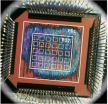Click here for more information.
BALTIMORE, Md. – A new prospective study of six-month-old infants at high genetic risk for autism identified weak head and neck control as a red flag for autism spectrum disorder (ASD) and language and/or social developmental delays. Researchers at the Kennedy Krieger Institute concluded that a simple "pull-to-sit" task could be added to existing developmental screenings at pediatric well visits to improve early detection of developmental delays.
"Research aimed at improving early detection of autism has largely focused on measurement of social and communication development," said Dr. Rebecca Landa, study author and director of the Center for Autism and Related Disorders at Kennedy Krieger Institute. "However, disruption in early motor development may also provide important clues about developmental disorders such as autism."
Dr. Landa will present this and other new research on motor delay and how it impacts development of language and social skills at the International Meeting for Autism Research, an annual scientific meeting convening May 17 in Toronto to provide researchers from around the world with a focused opportunity to share the rapidly moving scientific investigation of ASD.
While previous studies have shown that head lag indicates developmental delays in children with cerebral palsy and preterm infants, postural control in infants at risk for ASD had not been examined. In the current study, Dr. Landa and her team assessed infants in a "pull-to-sit" task, a simple measure of postural control in infants. Typically developing infants achieve this type of postural control by four months of age.
VIDEO: New research from Kennedy Krieger finds that a simple pull-to-sit task at six months of age may predict risk of an autism spectrum disorder. Researchers at Kennedy Krieger identified weak...
Click here for more information.
Dr. Landa's team studied two groups of infants. The first group consisted of 40 infants, ages 5.6 to 10 months, considered to be at high genetic risk because a sibling had autism. Dr. Landa and her team examined their ability to maintain head alignment when being carefully, yet firmly, pulled by the arms from lying flat on his/her back to a sitting position. Infants were scored according to whether their head maintained alignment with the spine, or was in front of the spine, during the task. Lack of this head control indicated head lag.
Participants were tested for head lag at 6, 14, 24, and, for outcome diagnosis, at 30 or 36 months, the age that diagnosis of ASD is considered definitive. At the end of the longitudinal study, infants were classified into three outcomes:
90% of infants diagnosed with ASD exhibited head lag as infants; 54% of children meeting criteria for social/communication delay had exhibited head lag as infants, and; 35% of children not meeting the criteria for social or communication delay or ASD exhibited head lag at 6 months.
In the second group, researchers examined six-month-olds at a single point in time for the presence of head lag. Dr. Landa and her team found that 75% (n =15) of high-risk infants exhibited head lag, compared to 33% (n =7) of low-risk infants, further supporting that head lag is more likely in infants at risk of developing ASD. "Our findings show that the evaluation of motor skills should be incorporated with other behavioral assessments to yield insights into the very earliest signs of autism," said Dr. Landa.
"While previous research shows that motor impairments are linked to social and communication deficits in older children with autism, the field is just starting to examine this in younger children," said Dr. Landa. "Our initial research suggests that motor delays may have an important impact on child development."
Building on the head lag research, Dr. Landa's team conducted a separate longitudinal study with 14-, 24- and 36-month-old children at high and low risk of developing ASD. The study found that motor delay becomes increasingly evident as children with ASD near their third birthday, yet not all children with ASD experience motor delay. Results showed that children with ASD who experience motor delays are more severely impaired by three years of age than children with ASD with no motor delays.
"While more research is needed to examine why not all children with ASD experience motor delay, the results of our studies examining motor development add to the body of research demonstrating that early detection and intervention for infants later diagnosed with autism is possible and remains crucial to minimize delays and improve outcomes," said Dr. Landa.
Kennedy Krieger researchers will present the head lag findings during a poster session on Friday, May 18 between 1:00 – 5:00 p.m. ET in the Sheraton Centre Toronto, Sheraton Hall. Dr. Landa's presentation about the impact of motor delays on development will be held on Friday, May 18 at 3:15 p.m. in Grand Ballroom East.
###
Other researchers who contributed to the head lag study were Joanne Flanagan, MS, OTR/L, of Kennedy Krieger Institute; Anjana Bhat, PT, PhD, of the University of Connecticut; and Margaret Bauman, MD, of Harvard Medical School and Massachusetts General Hospital.
Support for the head lag study was provided by National Institutes of Mental Health, Cure Autism Now (now Autism Speaks) and The Karma Foundation.
About the Kennedy Krieger Institute
Internationally recognized for improving the lives of children and adolescents with disorders and injuries of the brain and spinal cord, the Kennedy Krieger Institute in Baltimore, MD serves more than 16,000 individuals each year through inpatient and outpatient clinics, home and community services and school-based programs. Kennedy Krieger provides a wide range of services for children with developmental concerns mild to severe, and is home to a team of investigators who are contributing to the understanding of how disorders develop while pioneering new interventions and earlier diagnosis. For more information on Kennedy Krieger Institute, visit www.kennedykrieger.org.
END


